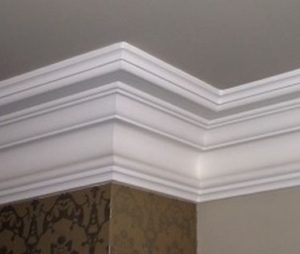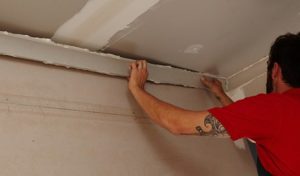Briefly about ceiling cornices
 These designs allow you to visually make the ceilings higher and give the interior solution a finished look. That is why cornices that are mounted on the ceiling are replacing wall cornices and curtains. They are easy to fit into almost any design.
These designs allow you to visually make the ceilings higher and give the interior solution a finished look. That is why cornices that are mounted on the ceiling are replacing wall cornices and curtains. They are easy to fit into almost any design.
They are distinguished by their low weight, low cost and simple lines. But this does not in any way affect their durability. Their installation is simple, regardless of the shape of the window over which they need to be fixed and its width. They move easily across the ceiling and are easy to care for.
What types of ceiling cornices are there?
Foamed polyurethane
Polyurethane structures are lightweight and flexible. You can hang textiles on it or simply decorate the surface of the ceiling with it. It is suitable for decorating arches and other architectural solutions.
This material is lightweight, and it is easy to install it yourself, without having complex tools at hand or without the skills of a repairman/finisher.
The polyurethane cornice can be painted in the color you like and is not affected by room humidity. And when the temperature changes, it will not lose its shape.
Gypsum
 This is a decorative baguette that covers the space at the junction of the ceiling and wall. This product is environmentally friendly. It will not cause allergic reactions in the owner of the room, which is invaluable if it is intended to decorate a nursery.
This is a decorative baguette that covers the space at the junction of the ceiling and wall. This product is environmentally friendly. It will not cause allergic reactions in the owner of the room, which is invaluable if it is intended to decorate a nursery.
The material does not burn, looks beautiful, is durable, and does not shrink. Such a cornice can be easily restored and painted as it ages. The appearance of this element is luxurious. It will show the well-being of the home owners. In addition, the gypsum cornice will absorb excess moisture in the room well and quickly release it back if there is a lack of moisture in the room.
Polystyrene
 Polystyrene cornices perfectly hide defects and errors during repairs. They are low cost, but effectively transform the interior, giving it a finished look. They fit perfectly into any style and have many models, sizes and colors.
Polystyrene cornices perfectly hide defects and errors during repairs. They are low cost, but effectively transform the interior, giving it a finished look. They fit perfectly into any style and have many models, sizes and colors.
The basis for the product is a polymer substance consisting of many fine-cell sintered granules.
At its budget price, the material has many advantages. It is lightweight and visually looks a little worse than plaster cornices. The product made from it is durable and has a long service life. It is easy to install, it does not deteriorate under the influence of moisture or temperature changes. You can even cut it with an ordinary stationery knife.
How to glue
Required for work
Baguettes for the ceiling or cornices (their number depends on the size of the room); knife or hacksaw; gun for installation; special glue for fastening; acrylic based sealant.
Work progress:
- choice of material;
- Preparation;
- surface lining;
- preparation of cornices;
- gluing;
- final processing.
Material calculation
 The owner of the room should know that the higher the ceiling, the larger the baguette is selected. The stores have a wide selection of products that vary in size, material and color.
The owner of the room should know that the higher the ceiling, the larger the baguette is selected. The stores have a wide selection of products that vary in size, material and color.
Important! For a room measuring about 20 square meters with a ceiling height of 2.5 meters, it is better to select curtain rods up to 90 mm wide.
To calculate, we calculate the perimeter of the room by measuring it with a tape measure, then divide the learned number by 200 mm and round. It is better to buy one extra cornice in reserve.
Ceiling preparation, marking
In order for the product to adhere well to the surface, you need to carefully prepare it, removing all cracks and irregularities. After this we mark the surface. To do this, apply the first test die and mark its beginning and end with a pencil. We continue marking until the end of the dies. Using this procedure, installation will be easy and simple. Marks are made with a pencil and only in those places where they will be covered by baseboards.
Cutting cornices, baguette
 We select the angle from which installation will begin and file it at an angle of 45 degrees. Then we place the product and saw it into the slots, adjusting it to an inclination angle of 45 degrees. We adjust the joints with a knife.
We select the angle from which installation will begin and file it at an angle of 45 degrees. Then we place the product and saw it into the slots, adjusting it to an inclination angle of 45 degrees. We adjust the joints with a knife.
Installation
We load the glue into the gun and cover with a thin layer those surfaces of the cornice that will be connected to the wall and ceiling. Apply a few drops of glue to the joint. Press it to the surface for a few minutes.
After drying, we go over the joints from above with fine-grain putty, rubbing the visible joints. We pass the butt seams between the wall, ceiling, and sealant dies.
After this, we paint the product with water-based paint in the same tone as the ceiling itself. If desired, you can do this in two layers.
You can make a cornice not along the entire perimeter of the room, but only on one wall. To do this, we go down twenty centimeters below the ceiling, glue the cornices, paint them and make special lighting behind them. It will highlight the decorative detail of the room and highlight the ceiling.
Working with foam cornice;
You will need:
- plinth with fastening strip;
- fasteners for masking corners;
- putty;
- glue (for example, “Moment Installation”);
- acrylic based sealant;
- water-based paint;
- pencil;
- centimeter (roulette);
- stationery knife;
- miter box;
- mounting gun;
- rubber spatula.
Work progress
- surface leveling;
- selection of material and its calculation;
- marking;
- gluing;
- additional work.
Material calculation
 We measure the perimeter of the ceiling and set aside 10–15% of the resulting number for trimming. Typically, the standard length of a plinth is about 2 meters. Dividing by the length of the product, we get the number of complete piece curtain rods.
We measure the perimeter of the ceiling and set aside 10–15% of the resulting number for trimming. Typically, the standard length of a plinth is about 2 meters. Dividing by the length of the product, we get the number of complete piece curtain rods.
For standard 2.5 meter ceilings, it is better to take cornices with a width of up to 90 mm, and for “Stalinka” ceilings with 3 meter ceilings, the width can be up to 17–20 cm.
Ceiling preparation, marking
Initially, we completely prepare the surface of the wall and ceiling, paint, putty, sand, etc. It must be perfectly smooth. We apply the strip from the corner from which gluing will begin, mark the beginning and end with a pencil. We mark the location of each plank in turn. This way, we can glue the cornices as quickly and accurately as possible.
Slicing
The baguettes are cut into the required size using a knife, the corners are adjusted using a miter box. To do this, you need to place the cornice in it the way it will stand in the wall and cut it with a hacksaw (stationery knife). Cutting starts from the corner, then selects the length.
Do not put too much pressure on the product so that it does not start to crumble. Burrs resulting from cutting are cleaned with sandpaper.
Installation
Before gluing, all preparatory work on the walls and ceiling must be completed. The surface must be perfectly flat.
Fastening can be done in two ways:
- gluing to wallpaper;
- wall mounting.
It's best to stick them on the wall.
How to glue to a stretch ceiling
 To do this, you will need to make holes with a hammer drill, according to the holes on the ceiling cornice. You will need to drill a concrete slab, take a drill with a Pobedit tip. We install the dowels, soaking them in ceiling tile adhesive.
To do this, you will need to make holes with a hammer drill, according to the holes on the ceiling cornice. You will need to drill a concrete slab, take a drill with a Pobedit tip. We install the dowels, soaking them in ceiling tile adhesive.
It is mounted in two ways: open (before stretching the ceiling, a wooden block is placed in the installation site) and closed. With the open method, the block is strengthened with an insert in the places where there will be screws holding the cornice. The holes are secured with plastic rings so that the canvas does not tear or stretch during the installation of the baguette.
If the block is not installed when installing the ceiling, you can install it at a height of 20 cm from the wall. The edge of the ceiling is fixed to the beam with a wall molding. This technique produces a flowing shelf vault that appears higher than it actually is.
Conclusion
Baguettes and cornices help to refine the window, decorate the joints of the wall and ceiling, and also hide repair flaws. The most noble material can be considered gypsum. It is durable, beautiful and has a long service life. Fastening methods can be different, which allows you to combine the product even with suspended ceilings.


 1
1






How to glue ceiling cornices